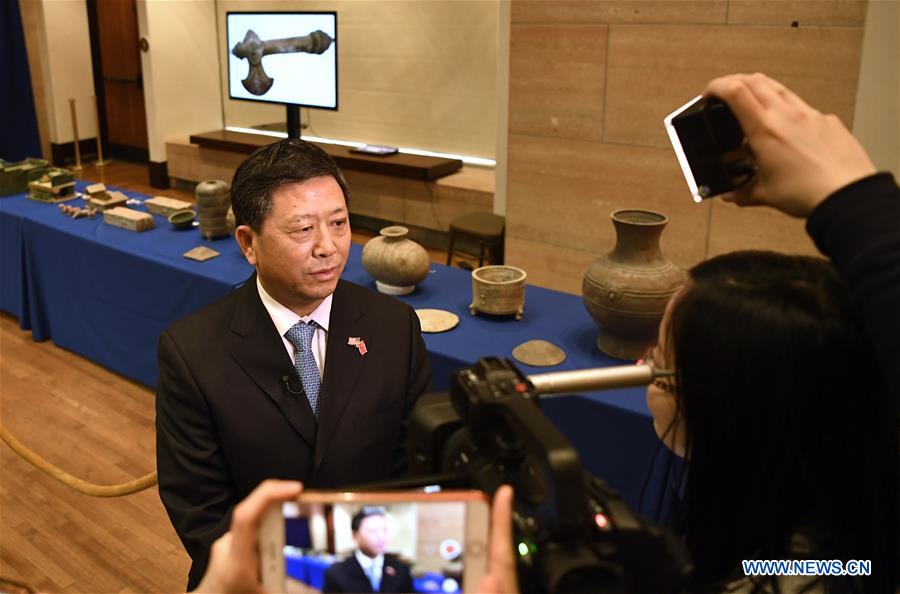China eyes further cooperation with US on relic preservation
China is willing to cooperate further with the United States in relics repatriation and protection, so as to promote a win-win and fair model for the international community at large, a senior Chinese official in charge of relic preservation said recently.
China is willing to cooperate further with the United States in relics repatriation and protection, so as to promote a win-win and fair model for the international community at large, a senior Chinese official in charge of relic preservation said recently.
Hu Bing, deputy chief of China's National Cultural Heritage Administration, speaks to reporters during a relics repatriation event held in the Eiteljorg Museum of Indianapolis, capital city of state of Indiana, the United States, on Feb. 28, 2019. [Photo/Xinhua]
Hu Bing, deputy chief of China's National Cultural Heritage Administration, made the remarks after attending a ceremony in Indianapolis, capital city of the U.S. state of Indiana, where the United States announced the repatriation of 361 pieces of Chinese relics and artifacts to China on Thursday.
The repatriation would bring back to China the largest batch of relics and artifacts from the United States since 2009, when the two nations signed a memorandum of understanding (MoU) to enhance cooperation in this respect.
These returned relics and artifacts, including a green glazed ceramic architectural model, were found by the U.S. Federal Bureau of Investigation (FBI) Indianapolis office in April 2014.
Hu told Xinhua that Thursday's repatriation highlights cooperation between the two nations' governmental institutions, including China's National Cultural Heritage Administration and its embassy in the United States, as well as the U.S. FBI and the Department of State.
China appreciates U.S. commitment and contribution to the protection of China's relics and artifacts, Hu said, noting that the latest repatriation, the third since 2009, represents the joint effort of the two nations and their support for each other, and will surely enhance the understanding and trust between the two peoples.
It also helps set a good example for the global effort in this regard and presents a gift to the 40th anniversary of the China-U.S. diplomatic relations, the Chinese official added.
Thanks to the first two rounds of repatriation in March 2011 and December 2015 since the 2009 MoU was signed, 36 pieces of relics and one ancient fossil have come back to their native country and been sent to major museums in China.
Hu noted that these relics and artifacts are an inseparable part of China's historical and cultural heritage, and it is in line with international protocol to enhance effort to repatriate cultural relics to their country of origin.
Hu also noted the robust momentum of bilateral cultural exchanges in the past 10 years, which were exemplified by the renewals of the MoU, joint archaeological activities, relic restoration, dozens' exhibitions of the Chinese cultural relics held in the United States, as well as the frequent cooperation between China's national relic-preservation institutions and U.S. prestigious counterparts like Smithsonian Institution, the Metropolitan Museum of Art and Harvard University.
Speaking of future plans to promote China-U.S. cultural relic cooperation, Hu suggested that the two sides pursue win-win results by advancing dialogues and coordination in such areas as relic restoration, exhibition and technology as well as heritage management.
Moreover, governments of the two nations shall enhance their partnership in terms of cultural heritage management around the globe, Hu said, adding that China is willing to work with the U.S. side to build a stable multi-dimensional cooperation network, support the international relic-protection initiative, engage in the establishment and enhance of international treaties, and commit to cultural relic preservation in conflict areas, and so on.
Noting that China has signed bilateral agreements with the United States and other 20 nations regarding combating relic theft, excavation and smuggling, Hu said China's National Cultural Heritage Administration has in recent years secured the return of over 4,000 pieces of relics through diplomatic, judicial and consultation channels, among others.
He added that China hopes to further its collaboration and exchanges with the U.S. side in fighting the looting, stealing and smuggling of cultural relics, to help secure an open and win-win cultural atmosphere in the world.


